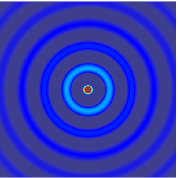
Photo from wikipedia
The accurate prediction of sound radiation from unbaffled vibrating plates remains a challenging problem. Finite structures make the sound waves diffract off and around the edges, an effect which is… Click to show full abstract
The accurate prediction of sound radiation from unbaffled vibrating plates remains a challenging problem. Finite structures make the sound waves diffract off and around the edges, an effect which is particularly strong at low frequencies. This phenomenon can be modeled with an edge source integral equation (ESIE) [A. Asheim, U. P. Svensson, J. Acoust. Soc. Am. 133 (2013) 3681-3691]. The modeling is based on a separation of the radiated sound into a geometrical-acoustics (GA) term, which equals the infinite-baffle solution, and diffraction of first- and higher orders. Expressions for the GA term and first-order diffraction are available explicitly, whereas higher-order diffraction is calculated through the solution of an integral equation. We present a method with a combination of time- and frequency-domain modeling which gives particularly efficient modeling. In this study, the sound radiation efficiency is targeted so only the sound field at the plate is computed. Thereby the numerically challenging rece...
Journal Title: Journal of the Acoustical Society of America
Year Published: 2017
Link to full text (if available)
Share on Social Media: Sign Up to like & get
recommendations!